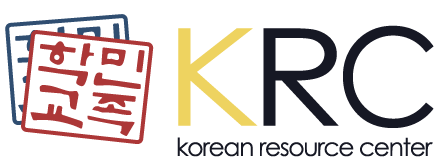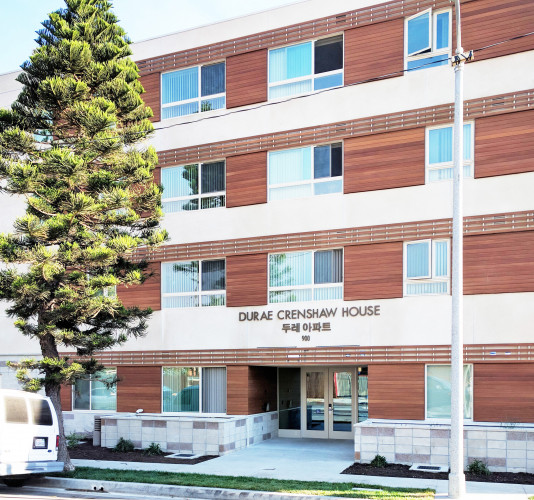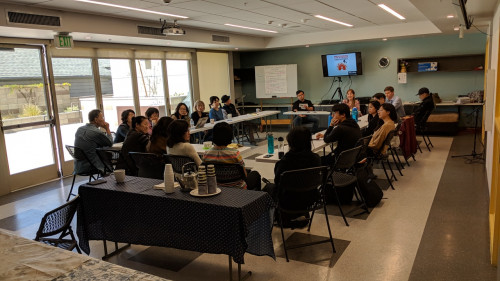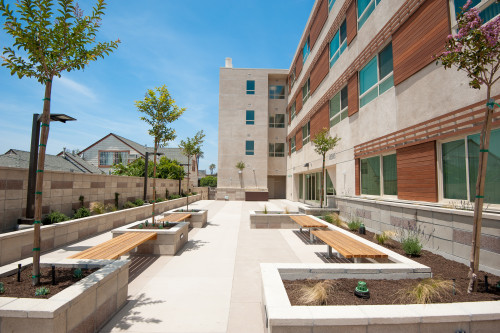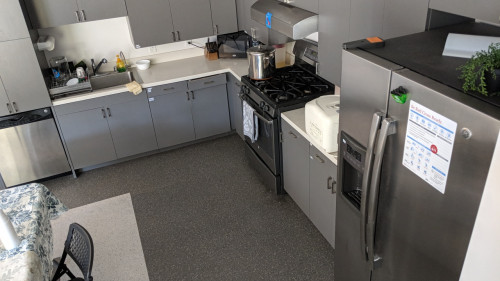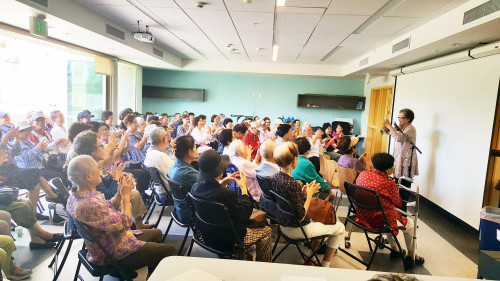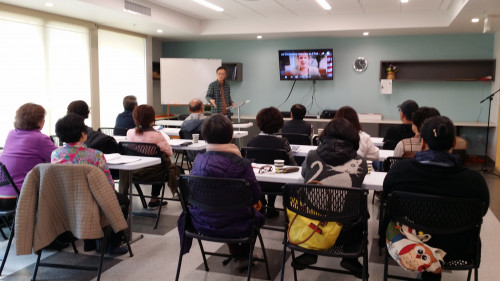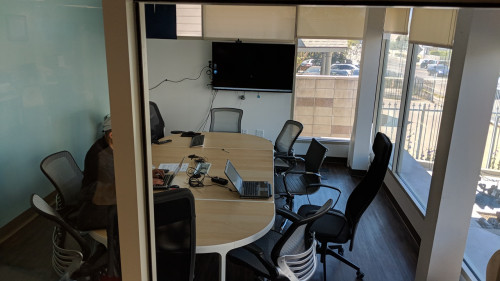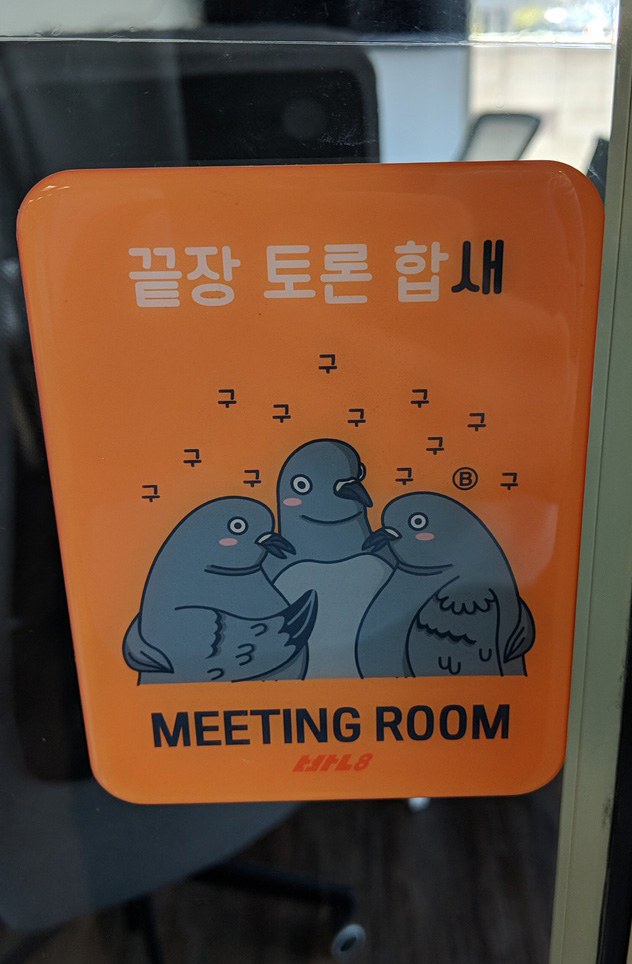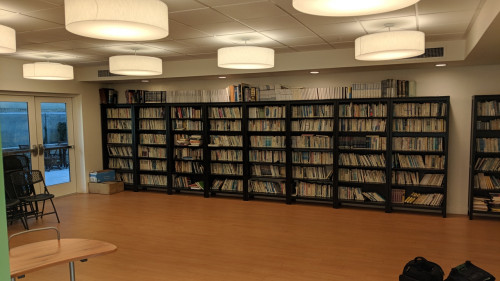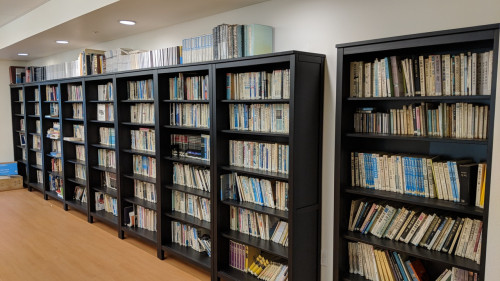Durae Senior Apartments was developed by Little Tokyo Service Center (LTSC), Decro Group and the Korean Resource Center (KRC), and provides 67 units of affordable housing for low-income seniors on two separate sites in the Koreatown/Wilshire neighborhood in Los Angeles, at 900 Crenshaw Boulevard and 540 South Kingsley Drive, respectively. 16 of the units are studios, 49 are one-bedroom units, and two one-bedroom manager’s units. KRC provides culturally specific services for the senior residents, many of whom are monolingual Korean-speaking. The lack of senior specific affordable housing has been one of the main obstacles to dignified lives for low-income seniors particularly as housing prices continue to rise in Los Angeles. The building establishes a new precedent for what can be achieved in gentrifying communities of color in Los Angeles.
“Durae” is a Korean word that roughly describes the ancient agrarian practice of community barn-raising. The spirit of helping one another is apt for Durae Senior Apartments, where it took a village to build this senior affordable housing complex, which was nearly ten years in the making. After surviving the Great Recession, it is now part of the solution to the local housing crisis. LTSC was able to weather the foreclosure crisis with a two-pronged approach: adding a third development partner and acquiring an additional site, which provided an economy of scale as well as a net increase in the total number of units. Koreatown, historically known for affordable rent-controlled apartments, has been experiencing a wave of gentrification with new luxury apartments under construction in recent years, exacerbating the housing crisis. Durae Senior Apartments received over 3,000 applications in just 17 days. This extreme demand for affordable housing is evidence of the dire importance of increasing housing available, especially for more vulnerable populations like seniors.
All units are affordable for seniors (ages 62 and above) with income ranges from 30% to 50% of the average median income of Los Angeles County. Design of the Durae Crenshaw House building integrates seamlessly with the neighborhood’s mixed zoning by combining a strong façade fronting Crenshaw with a more residential-friendly courtyard at the site’s core. Each apartment building includes secured subterranean parking, a large landscaped central courtyard, on-site laundry facilities and a community room with a kitchen. In addition, a property management office is located on the ground floor. The building has been designed to accommodate seniors at different stages in the aging process with various physical abilities. Individual units have grab bars, are pre-wired for emergency call systems and have no slip surfaces. It is projected that Durae Senior Apartments will exceed California’s Energy Efficiency Standards by over 20%.
In addition to providing high quality housing, the development offers community and social service space to its residents. On-site resident services provided by Korean Resource Center includes social and cultural services for seniors to maintain an active and connected lifestyle and provide any needed referrals to off-site health services. A resident manager also lives on-site to assist residents capable of independent living.
Thank You
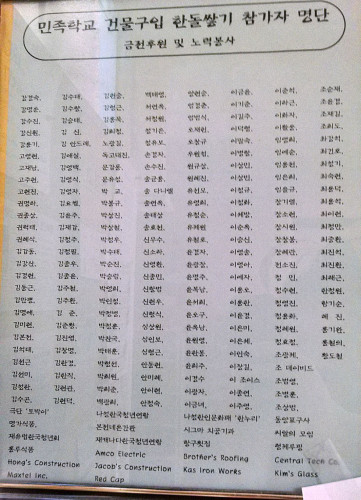 The opening of the two new affordable senior housing buildings represents a hard fought victory resulting from over a decade of organizing and advocacy by KRC and its seniors group. They are informed, low-income Korean American senior activists who have led and won major campaigns for language access, immigrant rights, health care, state funding for health and human services, redistricting, and now, the Durae senior homes.
The opening of the two new affordable senior housing buildings represents a hard fought victory resulting from over a decade of organizing and advocacy by KRC and its seniors group. They are informed, low-income Korean American senior activists who have led and won major campaigns for language access, immigrant rights, health care, state funding for health and human services, redistricting, and now, the Durae senior homes.
With a total development cost of nearly $26 million, Durae Senior Apartments would not have been possible without numerous funding partners including the California Debt Limit Allocation Committee, California Department of Housing and Community Development: Infill Infrastructure Grant, Housing and Community Investment Department of the City of Los Angeles, California Tax Credit Allocation Committee, Citi Bank, CRA/LA, Federal Home Loan Bank of San Francisco: Affordable Housing Program, MUFG Union Bank, and the Housing Authority of the County of Los Angeles. The Housing and Community Investment Department of the City of Los Angeles provided almost $8 million in funding, and Union Bank provided $10 million in tax credit equity investment.
We also would like to thank thousands of individual donors who contributed large and small amounts through the Brick by Brick Fundraising Campaign to support KRC's operations in the new builidings, and 250 donors of the 1998 Brick by Brick Capital campaign, where the land was purchased with contributions from the community. Their names are on the photo to the right.
Brick by Brick Fundraising Campaign
Brick by Brick harkens back to KRC's original grassroots campaign from the 1990s. During that time, KRC was still young and sustained solely by community support. With hundreds of community supporters, KRC was able to purchase its home at 900 Crenshaw Boulevard. Today, KRC has a 33-year track record of making changes that positively impact the community and society as a whole. The Brick by Brick Fundraising Campaign will raise the funds necessary for KRC to kick-start a new phase of community service, organizing, and advocacy.
Our "Friends of KRC Donor Wall" will be centrally located in the two senior apartments. By donating to the Brick by Brick Campaign, you can honor a special person whose name will be engraved onto the wall. The Donor Wall displays a treasured list of supporters who form the heart of KRC. Join the Brick by Brick Fundraising Campaign by purchasing your brick today!
Meeting the Challenge
We have seen thousands of community members struggle day to day for lack of affordable senior housing. For example, one our clients, Mr. Kim, immigrated to the United States in 1962 and later became a naturalized citizen. He has contributed to our community and also served in the U.S. Army for three years. He is now 62 years old, a diabetic and disabled following kidney surgery. Mr. Kim is an SSI recipient and has been waiting over three years for an available senior housing apartment. Stories like these are common across the community.
While the need is great given the tremendous surge in the senior population, there is simply not enough affordable housing available in Los Angeles. Generally, low-income seniors are financially vulnerable and without affordable housing, they must struggle to make ends meet in a city that is saturated with skyrocketing rent prices. Today, seniors are known to live longer and seek the ability to live independently. KRC and LTSC CDC believe that this project is an opportunity to meet the challenges that face us in the upcoming years and create affordable living spaces for local seniors who represent the bedrock of our society and community.
- As "baby boomers" begin turning 60, the number of Americans over 65 years old will double from 35 million to 70 million in 30 years. Seniors will then make up 1/4th of the total population.
- In California, by 2010, 1 in 5 Californians will be 60 years of age or older and by 2040, the senior population will reach 12.5 million, a 22% increase from 1990.
- In Los Angeles County, 19% of the population were 60 years and older in 2000. This figure is expected to increase to 28% in 2030.
- The poverty rate for seniors residing in the 1 mile radius of the Project site is 20% --- this figure is 10% higher than the rest of Los Angeles County.
- Seniors often wait an average of 5 to 7 years to move into an affordable housing unit.
Services, Programs and Amenities
 The two sites serve as the new home of KRC, allowing it to continue its mission of being the locus for grassroots organizing and community education for Koreatown residents and the larger community. They provide much-needed housing for 65 low-income senior households and offer vital programs and services to residents and the wider community. These include: Health Access, Immigrant Rights, Civic Engagement, Affordable Housing Counseling, Financial Empowerment, Youth Leadership Development, and Cultural Programs.
The two sites serve as the new home of KRC, allowing it to continue its mission of being the locus for grassroots organizing and community education for Koreatown residents and the larger community. They provide much-needed housing for 65 low-income senior households and offer vital programs and services to residents and the wider community. These include: Health Access, Immigrant Rights, Civic Engagement, Affordable Housing Counseling, Financial Empowerment, Youth Leadership Development, and Cultural Programs.
On-site resident services provided by KRC include social and cultural services for seniors to maintain an active and connected lifestyle and provide any needed referrals to off-site health services. A resident manager also lives on-site to assist residents capable of independent living.
Resident amenities include subterranean parking, landscaped central courtyard, laundry facilities and a community room with kitchen.
Crenshaw Community Room
Crenshaw offers a Community Room used for resident social activities, community events, meetings, and press conferences. With a maximum occupancy of 68 people, the room provides foldable tables and chairs, Wi-Fi connectivity, a 50" TV connected to a Chromecast 2.0 device, Windows computer and cable TV (HDMI, VGA and Mini DisplayPort via adapter connections available), as well as a ceiling projector displaying into a 10 feet wide screen, also connected to a Windows computer (HDMI/MiniDP and VGA connections available), ceiling speakers (Microphone, 3.5mm, computer and bluetooth connections available), a digital piano, and a small kitchen with stove, sink, fridge, rice cooker and microwave. The community room has a foldable window-door on its entire south side, opening into the courtyard. Maximum occupancy: 75
Crenshaw Conference Room
A part of KRC's office space, the Conference Room is used for meetings. The room is equipped with a 55" TV connected to a Chromecast device and a Windows computer (HDMI connection available), three tabletop omni microphones and webcam connected to the computer for videoconferencing support, and rolling whiteboard.
Kingsley Community Room
Kingsley offers a Community Room used for resident social activities, community events, meetings, and press conferences. The room provides foldable tables and chairs a 50" TV connected to a Chromecast 2.0 device and Windows computer (HDMI and VGA via adapter connections available), digital piano, small whitebard, two single-seat couches, over 2,000 books, and has a door leading to the courtyard. Maximum occupancy: 50
Management
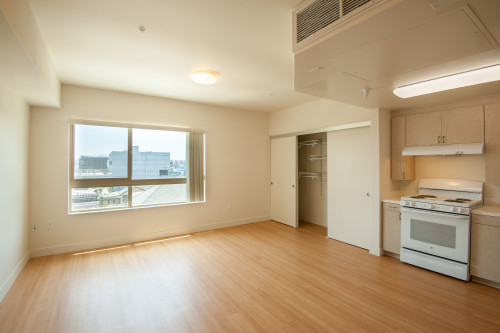 The apartment manager's office phone number is 323-938-1354. This property is managed by Levine Management Group.
The apartment manager's office phone number is 323-938-1354. This property is managed by Levine Management Group.
Currently as of April 2018, there are no available rooms left, but feel free to check on the apartment for room availability. When rooms become available, applicants must meet the below criteria:
- Annual household income of 50% of Area Median Income or less based on household size
- Head of Household must be at least 62 Years of Age by move-in date. For married couples, only one of them needs to be over 62 years old. Also caretakers are eligible.
- Maximum of 3 persons per 1 BR and 2 persons per studio (other restrictions apply
Units consist of studios (400 – 452 SF) and one-bedroom units (561 – 627 SF), with 35 units (28 one bedrooms, 7 studios) at Kingsley and 32 units (22 one bedrooms, 9 studios) at Crenshaw. Rents range from approximately $412 to $704 / month.
Income – There are units that range from targeting people earning 30% Area Median Income (AMI) to up to 50% AMI. The AMI is constant for all of Los Angeles, but it gets updated every year, so we can't say exactly what it will be. The income limits also vary depending on if there will be one, two, or three person occupancy in the units. The Housing Authority of the City of Los Angeles has information about income.
Q1: Does immigration status matter to apply?
Anyone may apply regardless of immigration status or California residency as long as they meet the eligibility criteria outlined above.
Q2. How is the rent price determined?
The rents are as low as we could make them while still being able to pay for construction, taxes, and on-going expenses. Each renter may have different rent prices depending on the specifications of the unit, the renter’s income, and family size.
Q3. Do you only qualify if you fall between 30%-50% of the Area Median Income?
The household maximum earnings are 50% AMI, but you do not necessarily need to have a minimum of 30% AMI. Senior households may still qualify with income at 10% AMI (for example, seniors on SSI with Section 8 Choice Vouchers).
Q4. How do they determine the “Area” in the AMI?
The U.S. Department of Housing and Urban Development determines this for all locations in the United States. They do this to adjust the income limits based on different market factors (i.e. rent in Iowa is much lower than rent in Los Angeles). For most cities, there is a MSA, a Metropolitan Statistical Area, which covers the entire city. This is true for Los Angeles. The median income may change every year.
Q5. If my total income consists mainly of SSI, do I qualify for LDK Senior Apartments?
Applicants may still qualify, depending on other circumstances (such as having Section 8 Vouchers). Applications will be reviewed on a case-by-case basis. Applicants should submit their pre-application honestly and if they are selected by lottery to complete a full application, they will be contacted to review their finances in more detail. The property management company will confirm that a prospective tenant has adequate resources to be able to pay their rent each month.
Q6. Does the Section 8 Voucher program count towards applicant’s income?
A section 8 Voucher does not increase a prospective tenant’s income (% AMI), but it shows that the tenant will be able to pay rent. LDK Senior Apartments accepts eligible applicants with tenant-based vouchers, but there are no project-based vouchers available for the project. A senior with SSI monthly income of $890 and a voucher would likely qualify, assuming there are no other disqualifying factors.
